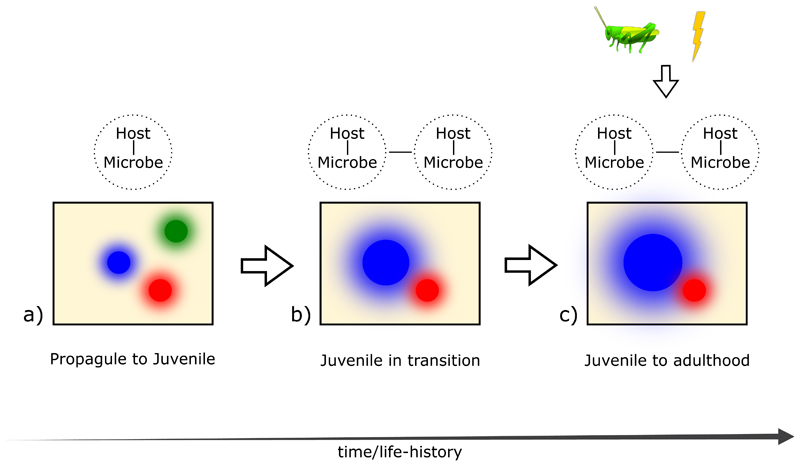Fig. 1.
Host-microbe interactions are ubiquitous throughout the hosts life-cyle. Proposed framework, portraying macroorganisms as “hosts” and community assembly as a progressive series of host-microbe interactions. The framework also includes the microbial interactions that shape microbial community structure before the arrival of any host in a given environment. a) After propagule arrival, we emphasize that mainly interactions between propagules/juvenile individuals and the local microbial community determine early host establishment in a given habitat. Propagules or juveniles (red, blue and green) colonize a new environment with defined abiotic conditions (yellow background). The microbiome of the introduced propagules (halos around circles) interacts with the already present microbiome of the environment. b) Competition among the surviving juvenile/adult species will happen within this host-microbe interactions matrix and will thus always entails a microbial component. Host-host competition should therefore be seen as an ecological interaction mediated by the respective microorganisms associated with each host. Possible outcomes of early host interactions would range from exclusion (green circle disappears) due to diseases and ultimate death; to survival (red circle stays at the same size) and growth (size of blue circle increases) when host-microbe interactions become commensalistic or mutualistic. While the juvenile transitions its microbiome coalesces with the environmental microbiome, and the other microbiomes of the developing macroorganismic community (overlapping halos around the circles) c) Finally, other higher-level trophic interactions that are more prominent between late juveniles to adult individuals will take place. As previously mentioned, the exact outcome from this spectrum of interactions would depend on the environmental background in front of which they occur. Here, further facilitative effects (blue circle size further increases) might occur. At this point, higher trophic-interactions or disturbances can further influence the community composition.

